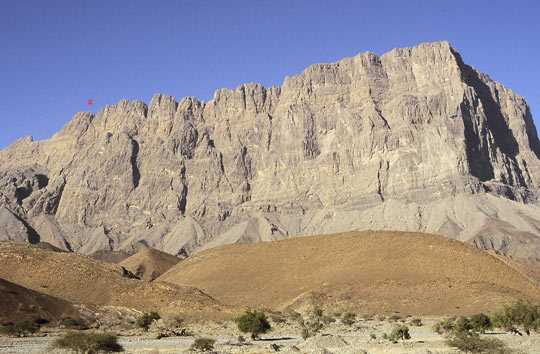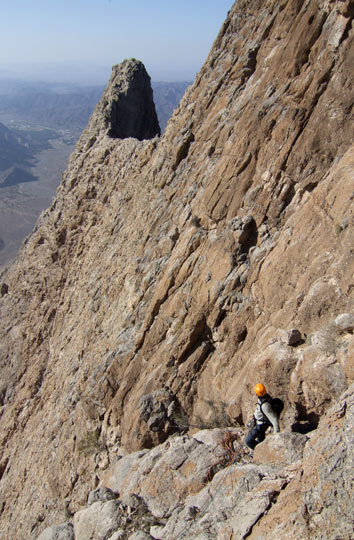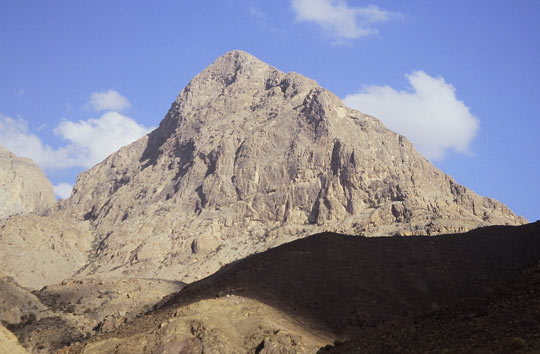
The broad south face of Jabal Misht (2090m), bounded on the right by the prominent 1979 French Pillar. The new December 2007 route, Rock Vulture (TD-: 5.8 R, 505m, Knott-Simpson, 2007), climbs the slabby face to the tower marked (A). The 1982 Davis-King-Searle Route reaches the broad col to the left, while Madam Butterfly (TD: 5.9, 700m, Chaudrey-Hornby, 2000) climbs up the face to the broad, flat-topped tower immediately to the right. [Photo] Paul Knott
A month before the Slovenians Pavle Kozjek and Dejan Miskovic made their new route on the southeast face of Jabal Misht (see the January 29, 2008 NewsWire), the New Zealand based British mountaineer, Paul Knott, returned to Oman (see the March 5, 2007 NewsWire for a report on his January 2007 ascents), and with fellow Christchurch climber, Richard Simpson, put up seven new routes, all at accessible grades. In every case the pair followed natural lines of weakness, climbing in traditional style with only nuts and camming devices, as has been the generally accepted ethic in the high mountain area.
The two concentrated on the better-known Western Hajar, a 300-kilometer chain of limestone peaks running the length of northern Oman, with the waters of the Gulf of Oman and Arabian Sea to the north and east, and the wide-open desert of the Empty Quarter to the west. This is the region where technical climbing in Oman first began.
In 1979 the famous Ecrins guide, Raymond Renaud, and two fellow French guides climbed the ca. 900m-high prominent pillar that separates the south and southeast faces of Jabal Misht (2090m). Reportedly, after their successful ascent the team was airlifted from the summit and taken to a grand reception at the Sultan’s Palace. Much aid was used, but on the second ascent, in 1993, it was climbed completely free at 5.11.
The British geologist Mike Searle visited the area for academic purposes in the early 1980s and in 1982, with Phillip Davis and Peter King, added the second recorded route in the country by climbing a straightforward line towards the left side of the extensive south face. Next year he climbed a meatier route closer to the French Pillar with King, Dana Coffield and Daniel Mithen (5.9, 16 pitches). Searle also climbed on Jabal Shams. The following year Oman resident, Bill Wheeler, who would go on to become one of the country’s most prolific pioneers, press ganged various partners into making an ascent of an obvious southwest-facing line on Jabal Kawr (2565m). After two attempts he succeeded with Chris Fenton and Vaughan Hewitt on the 560-meter National Day Route (D-: 5.7). At the time it was considered so “off the wall” that it received comprehensive coverage in all the Oman newspapers.

Richard Simpson above the crux of Rock Vulture (TD-: 5.8 R, 505m, Knott-Simpson, 2007) at the western end of Jabal Misht’s south face. The view extends along the sharp west ridge and into the arid far distance; Oman’s Empty Quarter. [Photo] Paul Knott
Knott and Simpson first examined the large spaces at the western end of Misht and came away with Rock Vulture (TD-: 5.8 R, 505m). They gained the broad ramp, which forms the key to the route, from a deep cleft via two exciting crux pitches on dubious rock followed by a rappel. The route lies well right of the 1982 Davis-King-Searle Route but left of Madam Butterfly, a 700-meter line put up in 2000 by the ubiquitous Geoff Hornby, who probably has climbed more than fifty new routes in Oman, and Aqil Chaudrey (TD: 5.9). Opposite Jabal Misht, on a southwestern outlier of Jabal Misfah named Jabal M’Saw, Knott and Simpson put up White Knight (D+: 5.7, 545m) up the buttress left of his previous and only other route on the face, White Magic (TD-: 5.8, 570m, Hornby-Knott, 2005). Then, on the main north pillar of Jabal Assala’s furthest east tower (referred to by the friendly villagers below as “Lorbib”), they put up the delightful Orange Roughy (D: 5.7, 383m).
South of Jabal Kawr stands the accessible Jabal M’Seeb with its sunless north face. Here, the pair added two more routes to the existing three lines: Bloody Sunday (TD-: 5.8, 395m) sneaks through the overhanging head at the left side of the face and was named after the havoc a dislodged flake caused to the back of Knott’s hand; Moonshadow (D+ 5.8, 276m) is a shorter but still excellent line at the right hand end, featuring steep climbing up huge hollow blocks.
On the adjacent sunny face of Kawr the pair discovered Sunset Serpent up a buttress facing the M’Seeb hamlet. It is possibly the easiest route to this end of the Kawr plateau (D-: 5.5, 503m) and got its name from the hiss of a snake that startled the party on the entry pitches. However, at the top they were surprised to find a carefully-wedged faded cap bearing the coat of arms of the UAE. It seems likely this could mark the finish to the celebrated National Day Climb, in which case the latter follows an old watercourse just right of Sunset Serpent. An accurate description of the climb has never appeared; the most comprehensive information is that it lies “near to a white scar about one kilometer left of the Sheba Pillar.”
The final route climbed by Knott and Simpson took place on Christmas Day. Nadan Pillar is a striking feature rising 800 meters from the gorge that leads to the hidden cirque of Nadan. The pair weaved a route up slabs and ramps to the summit at AD+: 5.5, whilst below, in the gorge, work continued on the improbable and somewhat destructive project to build a road through the ancient boulder choke to Nadan village. The pair note that local people were as friendly as ever, and despite developing infrastructure in this part of the Hajar, they met no other climbers during their stay.

Jabal M’Saw from the northwest. Only two routes cross this face: White Magic (TD-: 5.8, 570m, Hornby-Knott, 2005), which follows the obvious rightward slanting diagonal line to hit the ridge just right of the summit, and White Knight (D+: 5.7, 545m, Knott-Simpson, 2007) which takes the buttress to the left. [Photo] Paul Knott